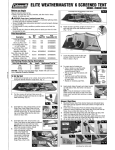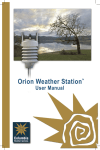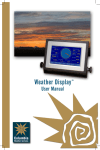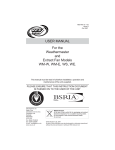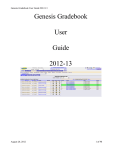Download How to Display Weather Data on a Web Page
Transcript
Columbia Weather Systems
Weather MicroServer™ Tutorial
How to Display Weather Data on a Web Page
Displaying your weather station’s data on the Internet is a great way to disseminate it — whether for general
public information or to make it available simultaneously to multiple parties involved in an Incident Response,
for example, responders, dispatchers, and commanders.
With Columbia Weather Systems weather stations there are two ways to get the weather data onto a web site
– WeatherMaster Software™ and the Weather MicroServer.™ This paper gives the procedure for posting
weather data to the Internet using the Weather MicroServer. (For information on using WeatherMaster to
upload weather data, please refer to the WeatherMaster User Manual.)
Setting this up is a fairly straightforward two-step process. You need to set up a web page to receive the XML
file data and you need to modify the settings in the MicroServer browser interface.
Please note: To display your weather data on a website in this method, your server must support .php files.
Setting up the Web Page
Create a web page that will draw the data from the XML file and
present it in formatted text/graphics.
You can see an example on our website at:
http://www.columbiaweather.com/orionweather_3.php
You can see the HTML code for this page in Appendix A.
It begins with the following code:
<?php
$orionData = readOrionData();
function readOrionData()
{
$orionDataUrl = “orion52.xml”;
$orionData = array();
$xml = new SimpleXMLElement($orionDataUrl, 0, true);
foreach ($xml->meas as $meas)
{
$orionData[(string) $meas[‘name’]] = (string) $meas;
}
return $orionData;
}
?>
“orion52.xml” is the designated name of the XML file Columbia Weather uploads to our website. You can
name your file whatever you want.
To display a parameter value the syntax is: <?php echo $orionData[‘parameter name’];?>
For example, to display wind speed use the following: <?php echo $orionData[‘mtWindSpeed’];?>
© 2010, Columbia Weather Systems, all rights reserved.
Columbia Weather Systems Weather MicroServer Tutorial
Display Weather Data on a Web Page
2
XML parameter names are listed in the Weather MicroServer User Manual, Section 3: Operation, under the
heading Measurements Definition.
Setting Up the MicroServer
You can set your Weather MicroServer to FTP the
XML weather data file to your website automatically.
The unit will FTP the file every 15 seconds.
In the MicroServer browser interface, click on Data
Output to bring up the screen shown at right.
Make sure the FTP Output: is [Enabled].
Enter your FTP URL followed by /filename.xml. You
can use any file name you want.
For example: ftp://www.yourURL.com/filename.xml
As another example, ours is:
ftp://www.columbiaweather.com/orion52.xml
(Recall the filename from the web page.)
Enter your website’s FTP user and password. If you
do not know what it is, contact your network administrator.
Set the Output Format: to [XML].
Click on the [Apply Changes] button.
At this point an XML file will be uploaded to your website.
About CWS
Columbia Weather Systems’ goal is to help organizations leverage weather data to optimize resources and
save lives. During the past decade, CWS has been at the forefront of innovation, utilizing cutting-edge
technology to capture and communicate weather data wherever it is needed.
Hundreds of organizations rely on CWS weather stations to monitor and disseminate weather information to
manage operations, prepare for emergencies, and help mitigate disasters.
For more information, contact Columbia Weather Systems, Inc.
Email [email protected]
Call toll-free in US and Canada 1 888-508-7375
Phone 503-629-0887
www.columbiaweather.com
© 2010, Columbia Weather Systems, all rights reserved.
Columbia Weather Systems Weather MicroServer Tutorial
Display Weather Data on a Web Page
3
Appendix A: HTML Code for CWS Web Page
<?php
$orionData = readOrionData();
function readOrionData()
{
$orionDataUrl = "orion52.xml";
$orionData = array();
$xml = new SimpleXMLElement($orionDataUrl, 0, true);
foreach ($xml->meas as $meas)
{
$orionData[(string) $meas['name']] = (string) $meas;
}
return $orionData;
}
?>
<html xmlns="http://www.w3.org/1999/xhtml" >
<head>
<title>Columbia Weather Systems Inc.</title>
<style type="text/css" media="screen">
.nav {width:730px; background-image: url("http://www.columbiaweather.com/Images/Menubar.gif"); }
.nav td a { font: 12px Arial, Helvetica, san-sarif; color: #333366; text-decoration: none; font-weight: bold }
.nav td a:hover { color: #FFFFFF; }
.head { background-image: url("http://www.columbiaweather.com/Images/Header.gif"); }
H1 { font: 15px Arial, Helvetica, san-sarif; color: #115F88; font-weight: bold; margin-bottom: 0%; margin-top: 1% }
TD { font: 12px Arial, Helvetica, san-sarif; color: #336699 }
.location { font: 15px Arial, Helvetica, san-sarif; color: #336699; font-weight: bold; }
.parameter { font: 17px Arial, Helvetica, san-sarif; color: #333366; font-weight: bold; }
.value { font: 17px Arial, Helvetica, san-sarif; color: #6E5A3C; font-weight: bold; }
.contact { font: 12px Arial, Helvetica, san-sarif; color: #336699; font-weight: bold; }
.contact a { font: 12px Arial, Helvetica, san-sarif; color: blue; }
.footnav { font: 12px Arial, Helvetica, san-sarif; color: blue; }
.foot { font: 10px Arial, Helvetica, san-sarif; color: #336699; }
.foot a { font: 10px Arial, Helvetica, san-sarif; color: blue; }
.quote { font: 16px Arial, Helvetica, san-sarif; color: #FFFFFF; font-weight: bold }
.quote a { font: 16px Arial, Helvetica, san-sarif; color: #FFFF33; text-decoration: none; font-weight: bold }
A:link { color: blue }
© 2010, Columbia Weather Systems, all rights reserved.
Columbia Weather Systems Weather MicroServer Tutorial
Display Weather Data on a Web Page
4
</style>
<meta http-equiv="refresh" content="30"/>
</head>
<body bgcolor="#FFFFFF" onLoad="">
<table width="730" border="0" cellspacing="0" cellpadding="0" height="75" class="head">
<tr>
<td width="18"></td>
</tr>
</table>
<table width="730" border="0" cellspacing="0" cellpadding="0" align="left" class="parameter">
<tr>
<td colspan="2">
<table width="450" border="0" cellspacing="0" cellpadding="0" align="center">
<tr>
<td class="location" width="225">Hillsboro, Oregon</td>
<td class="location" width="225">Time Stamp:<?php echo $orionData['mtSampTime'];?></td>
</tr>
</table>
<br></br>
<table width="450" border="1" cellspacing="0" cellpadding="5" align="center">
<tr>
<td class="parameter" width="225">Wind Speed<br/>
<div class="value"><?php echo $orionData['mtWindSpeed'];?> MPH</div></td>
<td class="parameter" width="225">Wind Direction<br/>
<div class="value"><?php echo $orionData['mtAdjWindDir'];?>°</div></td>
</tr>
<tr>
<td class="parameter" width="225">3-Sec Avg.<br/>
<div class="value"><?php echo $orionData['mt3SecRollAvgWindSpeed'];?> MPH</div></td>
<td class="parameter" width="225">3-Sec Avg.<br/>
<div class="value"><?php echo $orionData['mt3SecRollAvgWindDir'];?>°</div></td>
</tr>
<tr>
<td class="parameter" width="225">2-Min Avg.<br/>
<div class="value"><?php echo $orionData['mt2MinRollAvgWindSpeed'];?> MPH</div></td>
<td class="parameter" width="225">2-Min Avg.<br/>
<div class="value"><?php echo $orionData['mt2MinRollAvgWindDir'];?>°</div></td>
</tr>
<tr>
<td class="parameter" width="225">10-Min Avg.<br/>
<div class="value"><?php echo $orionData['mt10MinRollAvgWindSpeed'];?> MPH</div></td>
<td class="parameter" width="225">10-Min Avg.<br/>
<div class="value"><?php echo $orionData['mt10MinRollAvgWindDir'];?>°</div></td>
</tr>
</table>
<br></br>
<table width="450" border="1" cellspacing="0" cellpadding="5" align="center">
© 2010, Columbia Weather Systems, all rights reserved.
Columbia Weather Systems Weather MicroServer Tutorial
Display Weather Data on a Web Page
5
<tr>
<td class="parameter" width="225">Air Temperature<br/>
<div class="value"><?php echo $orionData['mtTemp1'];?>° F</div></td>
<td class="parameter" width="225">Avg Temperature Today<br/>
<div class="value"><?php echo $orionData['mtAvgTempToday'];?>° F</div></td>
</tr>
<tr>
<td class="parameter" width="225">Heat Index<br/>
<div class="value"><?php echo $orionData['mtHeatIndex'];?>° F</div></td>
<td class="parameter" width="225">Dew Point<br/>
<div class="value"><?php echo $orionData['mtDewPoint'];?>° F</div></td>
</tr>
<tr>
<td class="parameter" width="225">Wind Chill<br/>
<div class="value"><?php echo $orionData['mtWindChill'];?>° F</div></td>
<td class="parameter" width="225">Relative Humidity<br/>
<div class="value"><?php echo $orionData['mtRelHumidity'];?>%</div></td>
</tr>
<tr>
<td class="parameter" width="225">Barometric Pressure<br/>
<div class="value"><?php echo $orionData['mtAdjBaromPress'];?> In. Hg.</div></td>
<td class="parameter" width="225">Density Altitude<br/>
<div class="value"><?php echo $orionData['mtDensityAltitude'];?> Feet</div></td>
</tr>
</table>
<br></br>
<table width="450" border="1" cellspacing="0" cellpadding="5" align="center">
<tr>
<td class="parameter" width="225">Rain for the Day<br/>
<div class="value"><?php echo $orionData['mtRainToday'];?> Inches</div></td>
<td class="parameter" width="225">Rain for the Week<br/>
<div class="value"><?php echo $orionData['mtRainThisWeek'];?> Inches</div></td>
</tr>
<tr>
<td class="parameter" width="225">Rain for the Month<br/>
<div class="value"><?php echo $orionData['mtRainThisMonth'];?> Inches</div></td>
<td class="parameter" width="225">Rain for the Year<br/>
<div class="value"><?php echo $orionData['mtRainThisYear'];?> Inches</div></td>
</tr>
<tr>
<td class="parameter" width="225">Rain Intensity<br/>
<div class="value"><?php echo $orionData['mtRainIntensity'];?> Inches</div></td>
<td class="parameter" width="225">Rain Duration<br/>
<div class="value"><?php echo $orionData['mtRainDuration'];?> Seconds</div></td>
</tr>
</table> </td>
</tr>
<tr>
<td colspan="2"><hr width="700" color="#336699"/></td>
</tr>
</table>
</body>
</html>
© 2010, Columbia Weather Systems, all rights reserved.








